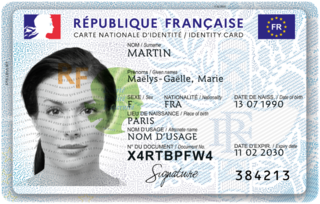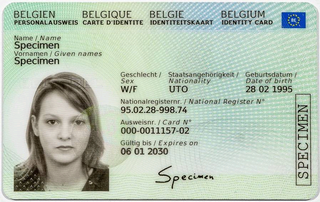An identity document is any document that may be used to prove a person's identity. If issued in a small, standard credit card size form, it is usually called an identity card, or passport card. Some countries issue formal identity documents, as national identification cards that may be compulsory or non-compulsory, while others may require identity verification using regional identification or informal documents. When the identity document incorporates a person's photograph, it may be called photo ID.

An Irish passport is the passport issued to citizens of Ireland. An Irish passport enables the bearer to travel internationally and serves as evidence of Irish nationality and citizenship of the European Union. It also facilitates the access to consular assistance from both Irish embassies and any embassy from other European Union member states while abroad.

The French national identity card is an official identity document consisting of an electronic ID-1 card bearing a photograph, name and address. While the identity card is non-compulsory, all persons must possess some form of valid government-issued identity documentation.

The Czech national identity card is the identity document used in the Czech Republic, in addition to the Czech passport. It is issued to all citizens, and every person above 15 years of age permanently living in the Czech Republic is required by law to hold a valid identity card.

The United States passport card is an optional national identity card and a travel document issued by the U.S. federal government in the size of a credit card. Like a U.S. passport book, the passport card is only issued to U.S. citizens and U.S. nationals exclusively by the U.S. Department of State. The passport card allows its holders to travel by domestic air flights within the U.S., and to travel by land and sea within North America. However, the passport card cannot be used for international air travel. US passport cards are used to verify identity and US citizenship. The requirements to attain the passport card are identical to the passport book and compliant to the standards for identity documents set by the REAL ID Act.

A Norwegian passport is the passport issued to nationals of Norway for the purpose of international travel. Beside serving as proof of Norwegian citizenship, they facilitate the process of securing assistance from Norwegian consular officials abroad.

Finnish passport are issued to nationals of Finland for the purpose of international travel. Aside from serving as proof of Finnish nationality, they facilitate the process of securing assistance from Finnish consular officials abroad.

Swedish passports are issued to nationals of Sweden for the purpose of international travel. Besides serving as proof of Swedish citizenship, they facilitate the process of securing assistance from Swedish consular officials abroad.

A Danish passport is an identity document issued to citizens of the Kingdom of Denmark to facilitate international travel. Besides serving as proof of Danish citizenship, they facilitate the process of securing assistance from Danish consular officials abroad.
There are several identity documents used in Sweden. None are compulsory by law, meaning that there is no formal penalty for not possessing one. Certified identification cards are issued by the tax agency. The Swedish police issues passports and national identity cards for Swedish citizens. A Swedish driver's license, issued by the transport agency, is also accepted as an identity document. Banks sometimes issue identity cards for established customers or their children.

The European Union itself does not issue ordinary passports, but ordinary passport booklets issued by its 27 member states share a common format. This common format features a colored cover emblazoned—in the official language(s) of the issuing country —with the title "European Union", followed by the name(s) of the member state, the heraldic "Arms" of the State concerned, the word "PASSPORT", together with the biometric passport symbol at the bottom center of the front cover.

The Croatian identity card is an identity document issued in Croatia. Any Croatian citizen who is resident in Croatia can obtain an ID card and it is compulsory for all citizens over the age of 18. This document is issued by the police on behalf of the Ministry of the Interior.

Serbian identity card is the national identification card used in Serbia. The document is issued by the Serbian Police on behalf of the Ministry of Internal Affairs and is the main form of identification on the territory of the Republic of Serbia. Although it can be issued to citizens above 10 years of age, all Serbian citizens over the age of 16 are legally obliged to carry their identity cards with them at all times and are subject to fines should they not. The identity card is a primary photo ID, Serbian passport and drivers license are used as valid photo IDs for various purposes.

The Bulgarian identity card is a compulsory identity document issued in Bulgaria. The document is issued by the police on behalf of the Ministry of Interior and is the main form of identification on the territory of the Republic of Bulgaria. All Bulgarians are obliged by law to carry their identity cards with them at all times and are subject to fines should they not.

The Swiss identity card in its current form dates back to July 1994. It is in the form of a plastic photocard. It can be used as a travel document when travelling within European Free Trade Association or to the European Union, the European microstates, Georgia, Turkey, and on organized tours to Tunisia.

The Finnish identity card is one of two official identity documents in Finland, the other being the Finnish passport. Any citizen or resident can get an identification card. Finnish citizens will get indication of citizenship on the card. It is available as an electronic ID card, which enables logging into certain services on the Internet, local computers or adding digital signatures into LibreOffice ODF documents or creating DigiDoc formatted containers that also allows encryption during content transfer. ID card is applied at a police station and it is issued by the police.

The German Identity Card is issued to German citizens by local registration offices in Germany and diplomatic missions abroad, while it is produced at the Bundesdruckerei in Berlin.
The Lebanese identity card is a compulsory Identity document issued to citizens of the Republic of Lebanon by the police on behalf of the Lebanese Ministry of Interior or in Lebanese embassies/consulates (abroad) free of charge. It is proof of identity, citizenship and residence of the Lebanese citizens.

The national identity cards are identity documents issued to citizens of nations in the European Union (EU) and European Free Trade Association (EFTA) member states, with the exception of Denmark and Ireland. The identity cards have been harmonized as a new common identity card model replaced the various formats in use on 2 August 2021.

The Norwegian identity card, commonly referred to as the national identity card in Norway, is a non-compulsory biometric identity document issued since 30 November 2020. It is one of two official identity documents issued by the Norwegian Police Service, the other being the Norwegian passport. It is only issued to Norwegian citizens, and may indicate citizenship so that it can be used as a travel document facilitating freedom of movement within the European Free Trade Association and the European Economic Area. For travel within the Nordic countries no identity documentation is legally required for Nordic citizens due to the Nordic Passport Union.






















